Critical Analysis of Contemporary Challenges to Human Rights Law
VerifiedAdded on 2022/09/27
|5
|1407
|20
Essay
AI Summary
This essay explores the contemporary challenges facing the human rights regime, primarily focusing on poverty, discrimination, and global inequalities. It highlights how poverty, characterized by the deprivation of basic amenities, hinders individuals from exercising their rights due to a lack of awareness and systemic failures in addressing their needs. The essay further discusses various forms of discrimination, including racial and gender biases, which undermine the fundamental principle of equal treatment. It also addresses global inequalities across education, health, and economic power, emphasizing the role of both horizontal (cultural and social) and vertical (wealth distribution) disparities. The essay suggests strategies to mitigate these challenges, such as enhancing economic, social, and political rights for impoverished populations, promoting egalitarianism through equal pay and humane education, and implementing economic policies to address wealth disparities. It concludes by advocating for a more advanced implementation of human rights that tackles the root causes of these issues and fosters a more equitable and just world.
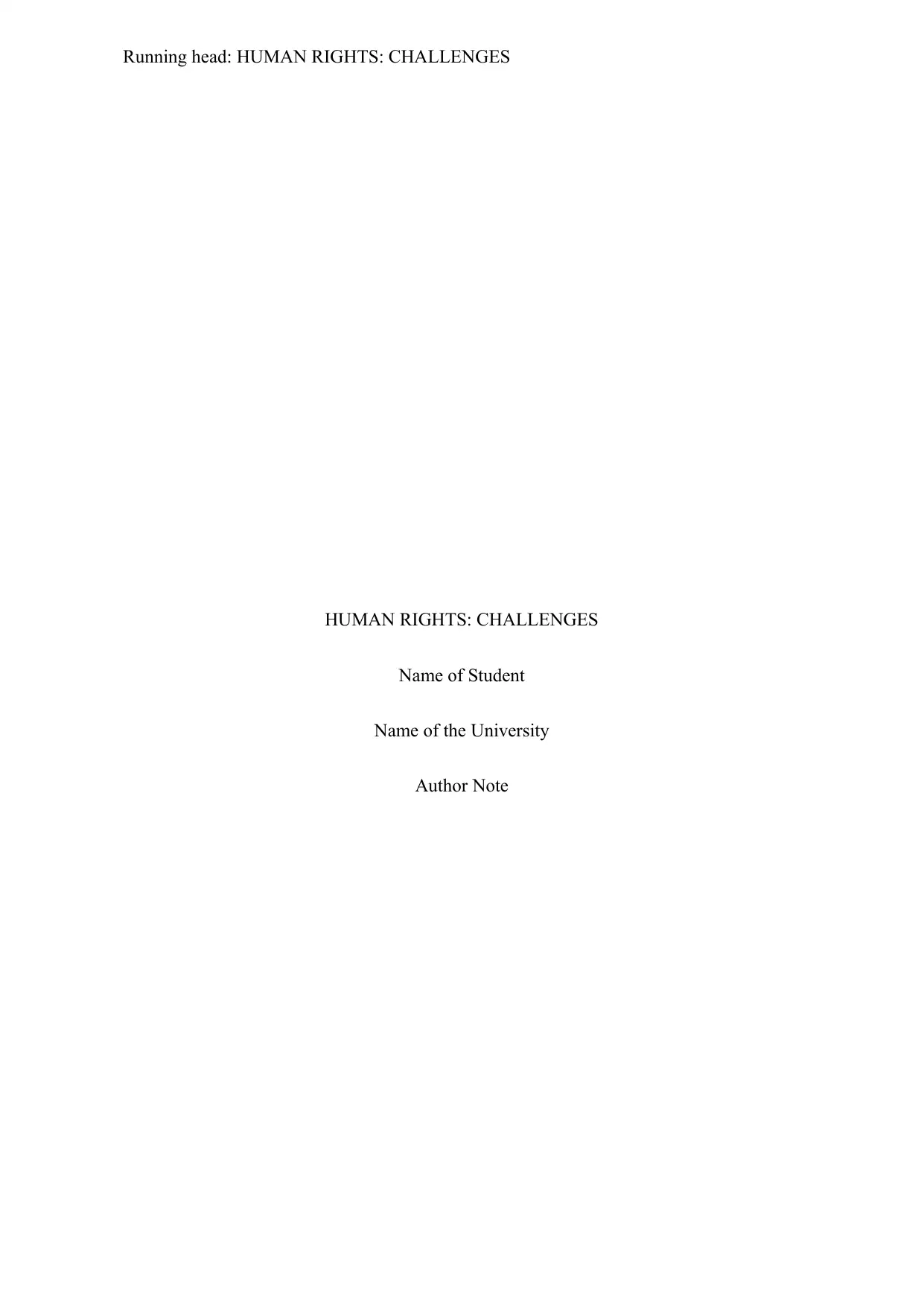
Running head: HUMAN RIGHTS: CHALLENGES
HUMAN RIGHTS: CHALLENGES
Name of Student
Name of the University
Author Note
HUMAN RIGHTS: CHALLENGES
Name of Student
Name of the University
Author Note
Paraphrase This Document
Need a fresh take? Get an instant paraphrase of this document with our AI Paraphraser
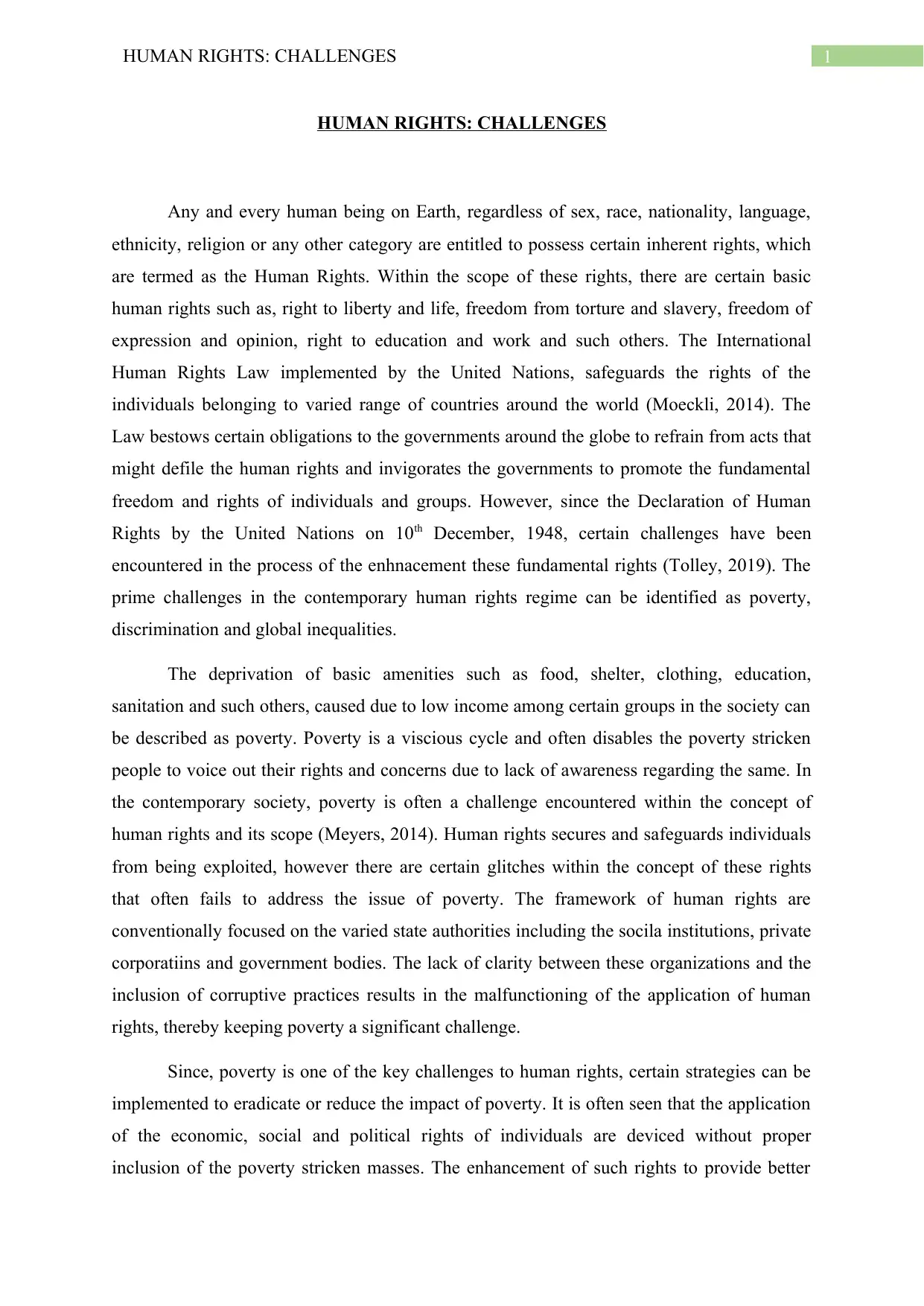
1HUMAN RIGHTS: CHALLENGES
HUMAN RIGHTS: CHALLENGES
Any and every human being on Earth, regardless of sex, race, nationality, language,
ethnicity, religion or any other category are entitled to possess certain inherent rights, which
are termed as the Human Rights. Within the scope of these rights, there are certain basic
human rights such as, right to liberty and life, freedom from torture and slavery, freedom of
expression and opinion, right to education and work and such others. The International
Human Rights Law implemented by the United Nations, safeguards the rights of the
individuals belonging to varied range of countries around the world (Moeckli, 2014). The
Law bestows certain obligations to the governments around the globe to refrain from acts that
might defile the human rights and invigorates the governments to promote the fundamental
freedom and rights of individuals and groups. However, since the Declaration of Human
Rights by the United Nations on 10th December, 1948, certain challenges have been
encountered in the process of the enhnacement these fundamental rights (Tolley, 2019). The
prime challenges in the contemporary human rights regime can be identified as poverty,
discrimination and global inequalities.
The deprivation of basic amenities such as food, shelter, clothing, education,
sanitation and such others, caused due to low income among certain groups in the society can
be described as poverty. Poverty is a viscious cycle and often disables the poverty stricken
people to voice out their rights and concerns due to lack of awareness regarding the same. In
the contemporary society, poverty is often a challenge encountered within the concept of
human rights and its scope (Meyers, 2014). Human rights secures and safeguards individuals
from being exploited, however there are certain glitches within the concept of these rights
that often fails to address the issue of poverty. The framework of human rights are
conventionally focused on the varied state authorities including the socila institutions, private
corporatiins and government bodies. The lack of clarity between these organizations and the
inclusion of corruptive practices results in the malfunctioning of the application of human
rights, thereby keeping poverty a significant challenge.
Since, poverty is one of the key challenges to human rights, certain strategies can be
implemented to eradicate or reduce the impact of poverty. It is often seen that the application
of the economic, social and political rights of individuals are deviced without proper
inclusion of the poverty stricken masses. The enhancement of such rights to provide better
HUMAN RIGHTS: CHALLENGES
Any and every human being on Earth, regardless of sex, race, nationality, language,
ethnicity, religion or any other category are entitled to possess certain inherent rights, which
are termed as the Human Rights. Within the scope of these rights, there are certain basic
human rights such as, right to liberty and life, freedom from torture and slavery, freedom of
expression and opinion, right to education and work and such others. The International
Human Rights Law implemented by the United Nations, safeguards the rights of the
individuals belonging to varied range of countries around the world (Moeckli, 2014). The
Law bestows certain obligations to the governments around the globe to refrain from acts that
might defile the human rights and invigorates the governments to promote the fundamental
freedom and rights of individuals and groups. However, since the Declaration of Human
Rights by the United Nations on 10th December, 1948, certain challenges have been
encountered in the process of the enhnacement these fundamental rights (Tolley, 2019). The
prime challenges in the contemporary human rights regime can be identified as poverty,
discrimination and global inequalities.
The deprivation of basic amenities such as food, shelter, clothing, education,
sanitation and such others, caused due to low income among certain groups in the society can
be described as poverty. Poverty is a viscious cycle and often disables the poverty stricken
people to voice out their rights and concerns due to lack of awareness regarding the same. In
the contemporary society, poverty is often a challenge encountered within the concept of
human rights and its scope (Meyers, 2014). Human rights secures and safeguards individuals
from being exploited, however there are certain glitches within the concept of these rights
that often fails to address the issue of poverty. The framework of human rights are
conventionally focused on the varied state authorities including the socila institutions, private
corporatiins and government bodies. The lack of clarity between these organizations and the
inclusion of corruptive practices results in the malfunctioning of the application of human
rights, thereby keeping poverty a significant challenge.
Since, poverty is one of the key challenges to human rights, certain strategies can be
implemented to eradicate or reduce the impact of poverty. It is often seen that the application
of the economic, social and political rights of individuals are deviced without proper
inclusion of the poverty stricken masses. The enhancement of such rights to provide better
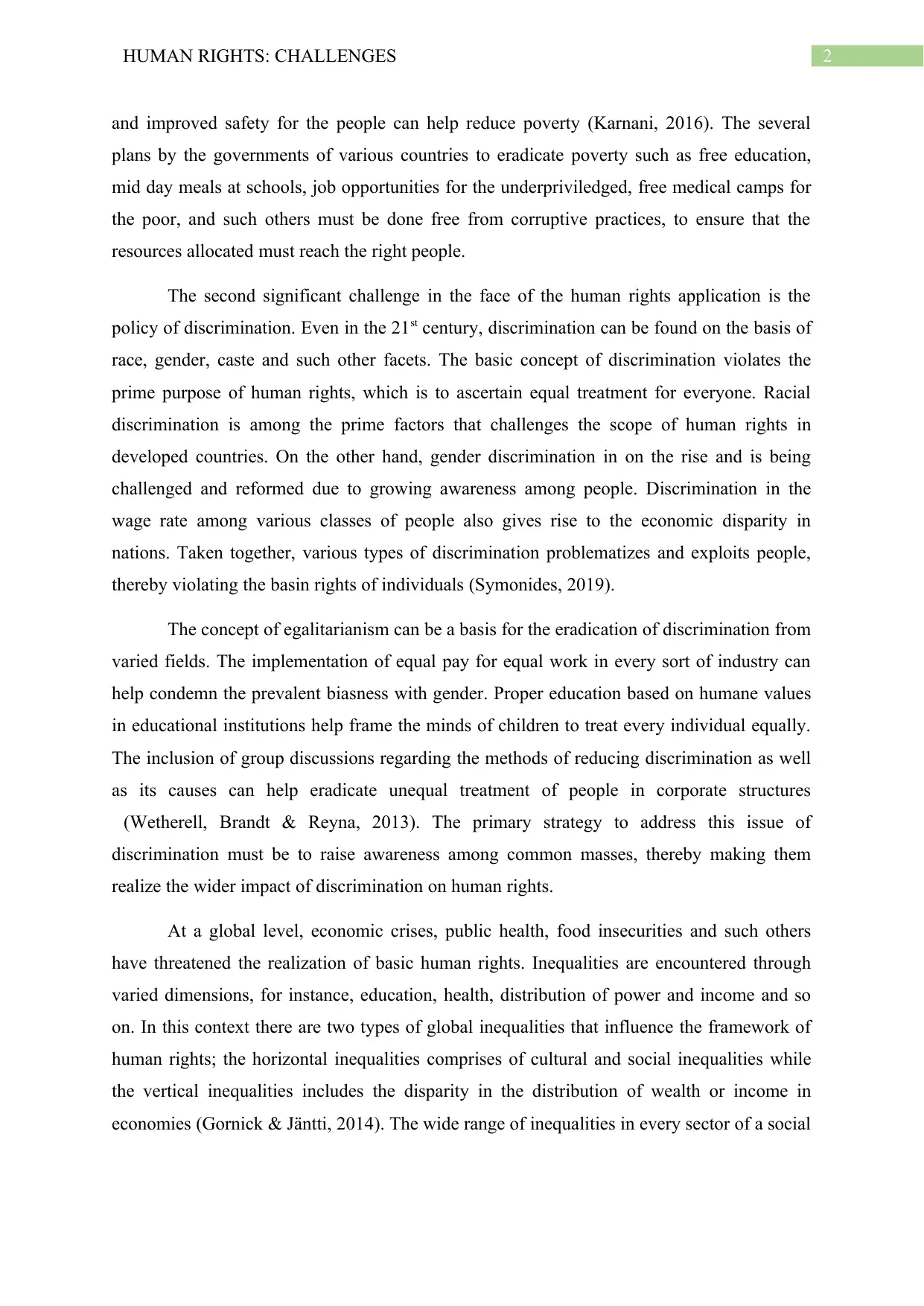
2HUMAN RIGHTS: CHALLENGES
and improved safety for the people can help reduce poverty (Karnani, 2016). The several
plans by the governments of various countries to eradicate poverty such as free education,
mid day meals at schools, job opportunities for the underpriviledged, free medical camps for
the poor, and such others must be done free from corruptive practices, to ensure that the
resources allocated must reach the right people.
The second significant challenge in the face of the human rights application is the
policy of discrimination. Even in the 21st century, discrimination can be found on the basis of
race, gender, caste and such other facets. The basic concept of discrimination violates the
prime purpose of human rights, which is to ascertain equal treatment for everyone. Racial
discrimination is among the prime factors that challenges the scope of human rights in
developed countries. On the other hand, gender discrimination in on the rise and is being
challenged and reformed due to growing awareness among people. Discrimination in the
wage rate among various classes of people also gives rise to the economic disparity in
nations. Taken together, various types of discrimination problematizes and exploits people,
thereby violating the basin rights of individuals (Symonides, 2019).
The concept of egalitarianism can be a basis for the eradication of discrimination from
varied fields. The implementation of equal pay for equal work in every sort of industry can
help condemn the prevalent biasness with gender. Proper education based on humane values
in educational institutions help frame the minds of children to treat every individual equally.
The inclusion of group discussions regarding the methods of reducing discrimination as well
as its causes can help eradicate unequal treatment of people in corporate structures
(Wetherell, Brandt & Reyna, 2013). The primary strategy to address this issue of
discrimination must be to raise awareness among common masses, thereby making them
realize the wider impact of discrimination on human rights.
At a global level, economic crises, public health, food insecurities and such others
have threatened the realization of basic human rights. Inequalities are encountered through
varied dimensions, for instance, education, health, distribution of power and income and so
on. In this context there are two types of global inequalities that influence the framework of
human rights; the horizontal inequalities comprises of cultural and social inequalities while
the vertical inequalities includes the disparity in the distribution of wealth or income in
economies (Gornick & Jäntti, 2014). The wide range of inequalities in every sector of a social
and improved safety for the people can help reduce poverty (Karnani, 2016). The several
plans by the governments of various countries to eradicate poverty such as free education,
mid day meals at schools, job opportunities for the underpriviledged, free medical camps for
the poor, and such others must be done free from corruptive practices, to ensure that the
resources allocated must reach the right people.
The second significant challenge in the face of the human rights application is the
policy of discrimination. Even in the 21st century, discrimination can be found on the basis of
race, gender, caste and such other facets. The basic concept of discrimination violates the
prime purpose of human rights, which is to ascertain equal treatment for everyone. Racial
discrimination is among the prime factors that challenges the scope of human rights in
developed countries. On the other hand, gender discrimination in on the rise and is being
challenged and reformed due to growing awareness among people. Discrimination in the
wage rate among various classes of people also gives rise to the economic disparity in
nations. Taken together, various types of discrimination problematizes and exploits people,
thereby violating the basin rights of individuals (Symonides, 2019).
The concept of egalitarianism can be a basis for the eradication of discrimination from
varied fields. The implementation of equal pay for equal work in every sort of industry can
help condemn the prevalent biasness with gender. Proper education based on humane values
in educational institutions help frame the minds of children to treat every individual equally.
The inclusion of group discussions regarding the methods of reducing discrimination as well
as its causes can help eradicate unequal treatment of people in corporate structures
(Wetherell, Brandt & Reyna, 2013). The primary strategy to address this issue of
discrimination must be to raise awareness among common masses, thereby making them
realize the wider impact of discrimination on human rights.
At a global level, economic crises, public health, food insecurities and such others
have threatened the realization of basic human rights. Inequalities are encountered through
varied dimensions, for instance, education, health, distribution of power and income and so
on. In this context there are two types of global inequalities that influence the framework of
human rights; the horizontal inequalities comprises of cultural and social inequalities while
the vertical inequalities includes the disparity in the distribution of wealth or income in
economies (Gornick & Jäntti, 2014). The wide range of inequalities in every sector of a social
⊘ This is a preview!⊘
Do you want full access?
Subscribe today to unlock all pages.

Trusted by 1+ million students worldwide
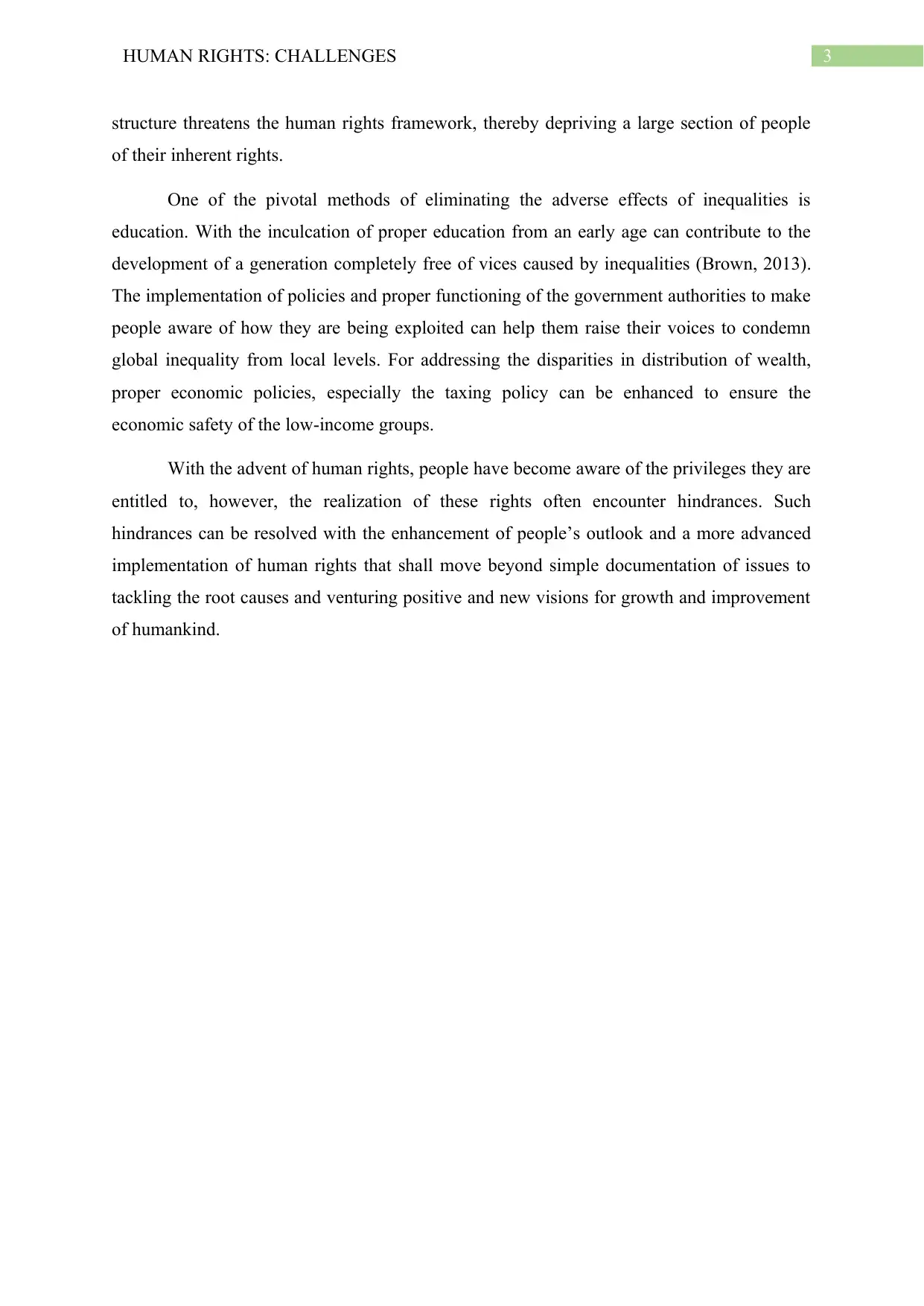
3HUMAN RIGHTS: CHALLENGES
structure threatens the human rights framework, thereby depriving a large section of people
of their inherent rights.
One of the pivotal methods of eliminating the adverse effects of inequalities is
education. With the inculcation of proper education from an early age can contribute to the
development of a generation completely free of vices caused by inequalities (Brown, 2013).
The implementation of policies and proper functioning of the government authorities to make
people aware of how they are being exploited can help them raise their voices to condemn
global inequality from local levels. For addressing the disparities in distribution of wealth,
proper economic policies, especially the taxing policy can be enhanced to ensure the
economic safety of the low-income groups.
With the advent of human rights, people have become aware of the privileges they are
entitled to, however, the realization of these rights often encounter hindrances. Such
hindrances can be resolved with the enhancement of people’s outlook and a more advanced
implementation of human rights that shall move beyond simple documentation of issues to
tackling the root causes and venturing positive and new visions for growth and improvement
of humankind.
structure threatens the human rights framework, thereby depriving a large section of people
of their inherent rights.
One of the pivotal methods of eliminating the adverse effects of inequalities is
education. With the inculcation of proper education from an early age can contribute to the
development of a generation completely free of vices caused by inequalities (Brown, 2013).
The implementation of policies and proper functioning of the government authorities to make
people aware of how they are being exploited can help them raise their voices to condemn
global inequality from local levels. For addressing the disparities in distribution of wealth,
proper economic policies, especially the taxing policy can be enhanced to ensure the
economic safety of the low-income groups.
With the advent of human rights, people have become aware of the privileges they are
entitled to, however, the realization of these rights often encounter hindrances. Such
hindrances can be resolved with the enhancement of people’s outlook and a more advanced
implementation of human rights that shall move beyond simple documentation of issues to
tackling the root causes and venturing positive and new visions for growth and improvement
of humankind.
Paraphrase This Document
Need a fresh take? Get an instant paraphrase of this document with our AI Paraphraser
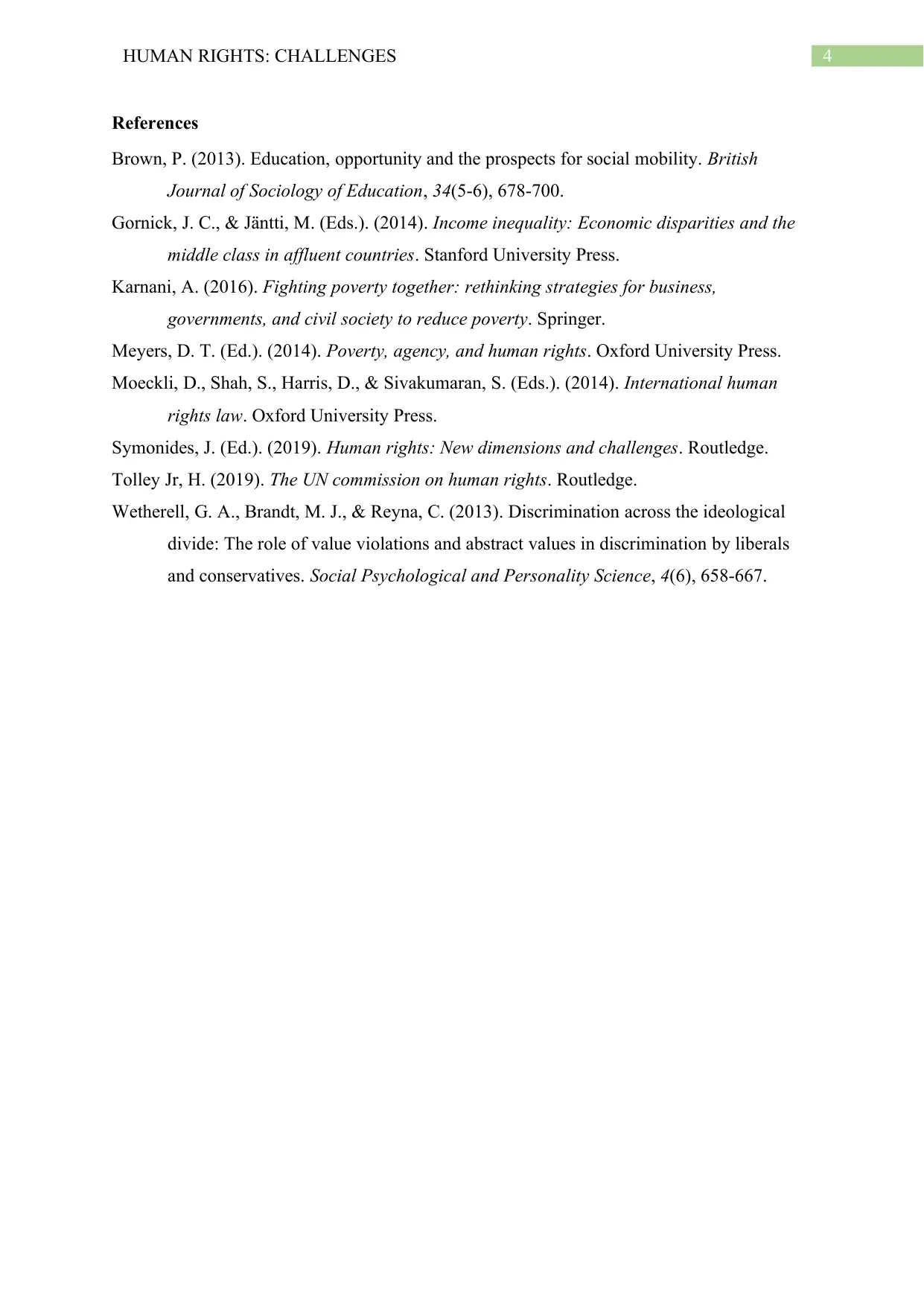
4HUMAN RIGHTS: CHALLENGES
References
Brown, P. (2013). Education, opportunity and the prospects for social mobility. British
Journal of Sociology of Education, 34(5-6), 678-700.
Gornick, J. C., & Jäntti, M. (Eds.). (2014). Income inequality: Economic disparities and the
middle class in affluent countries. Stanford University Press.
Karnani, A. (2016). Fighting poverty together: rethinking strategies for business,
governments, and civil society to reduce poverty. Springer.
Meyers, D. T. (Ed.). (2014). Poverty, agency, and human rights. Oxford University Press.
Moeckli, D., Shah, S., Harris, D., & Sivakumaran, S. (Eds.). (2014). International human
rights law. Oxford University Press.
Symonides, J. (Ed.). (2019). Human rights: New dimensions and challenges. Routledge.
Tolley Jr, H. (2019). The UN commission on human rights. Routledge.
Wetherell, G. A., Brandt, M. J., & Reyna, C. (2013). Discrimination across the ideological
divide: The role of value violations and abstract values in discrimination by liberals
and conservatives. Social Psychological and Personality Science, 4(6), 658-667.
References
Brown, P. (2013). Education, opportunity and the prospects for social mobility. British
Journal of Sociology of Education, 34(5-6), 678-700.
Gornick, J. C., & Jäntti, M. (Eds.). (2014). Income inequality: Economic disparities and the
middle class in affluent countries. Stanford University Press.
Karnani, A. (2016). Fighting poverty together: rethinking strategies for business,
governments, and civil society to reduce poverty. Springer.
Meyers, D. T. (Ed.). (2014). Poverty, agency, and human rights. Oxford University Press.
Moeckli, D., Shah, S., Harris, D., & Sivakumaran, S. (Eds.). (2014). International human
rights law. Oxford University Press.
Symonides, J. (Ed.). (2019). Human rights: New dimensions and challenges. Routledge.
Tolley Jr, H. (2019). The UN commission on human rights. Routledge.
Wetherell, G. A., Brandt, M. J., & Reyna, C. (2013). Discrimination across the ideological
divide: The role of value violations and abstract values in discrimination by liberals
and conservatives. Social Psychological and Personality Science, 4(6), 658-667.
1 out of 5
Related Documents
Your All-in-One AI-Powered Toolkit for Academic Success.
+13062052269
info@desklib.com
Available 24*7 on WhatsApp / Email
![[object Object]](/_next/static/media/star-bottom.7253800d.svg)
Unlock your academic potential
Copyright © 2020–2025 A2Z Services. All Rights Reserved. Developed and managed by ZUCOL.





